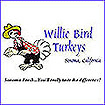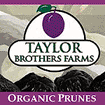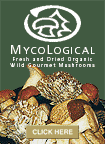|
Chef
Gary Danko
Danko's, San Francisco, CA |
By
Ellen Walsh
Making
an essence is a technique of reduction, then addition,
then reduction again, addition, six or seven times until you have
a rich viscous, brown medium that when strained off is the essence.
The stock has taken on the characteristic of the meat.
Gary
Danko makes only three kinds of stocks - a veal stock, poultry
stock, and a fish fume. Veal stock is the chameleon that can create
whatever essence you want. At Danko's restaurant, they use 200
pounds of veal breasts each week to make stock. Veal stock is
made once a week and poultry stock is made 2 times a week. After
the initial roasting, the veal stock takes 12 hours of simmering
while the chicken stock has to simmer for 3-4 hours.
The
essence is one of Gary Danko's favorite topic. He says, "The
essence is the heart and soul of the sauces. Once you make it,
you can take it in any direction you want." In order to make
a great sauce, you must first start out with the essence. The
essence is the modern equivalent of the demi-glace.
|
Click
on Images for Captions |
The
Essence
The beginning
of an essence is a good stock, a good dark stock. White stocks
are used when delicate flavors are needed, but dark stocks are
rich, full of flavor, and get your juices flowing. The secret
of getting the maximum amount of flavor out of the stock is in
the right proportions and treatment of bones, meats, the aromatics
and the liquids.
Roasting
The first step in creating the stock
is to roast the bones. "It is best to use a cut of meat that
is 50% bones and 50% meat in order to achieve a good stock. Bones
give the gelatin to the stock while meat gives the flavor: So,
for example, if you are making a veal stock using just bones,
it will be gelatinous but will have little or no flavor.
Start
by cutting the breast into 5-inch squares. Place them single layered
on a sheet pan with approximately 1 -inch of space between pieces
of meat. Roast in a 375 degree oven until meat is golden brown,
about 35 - 45 minutes. In the presence of heat, fat helps carmelize
the minerals, vitamins and natural sugars in the meat. When meat
is golden, remove from the oven and drain off fat immediately.
"It should get your sapid juices flowing, salivating."
Let pans cool. Remove meat from the pan and place in a large stockpot.
Place the sheetpans over a low flame and deglaze the carmelized
bits off the bottom with white wine. Pour deglazing liquids into
stockpot. Calculate the quantity of aromatics. Aromatics are flavor-bearing
vegetables such as peeled onions, carrots, leeks, parsley stems,
bay leaf and thyme. Place in stockpot and cover with cold water
to fill 2-inches above the bones and aromatics. Bring to a boil
and reducc to a simmer, where the bubble is breaking the surface
of the stock. Simmer at this rate for 12 hours. Strain the liquid
from stockpot and cool. This is the primary stock. To make a secondary
stock or romouillage cover the bones with cold water to just cover
the bones. Bring to a slow
simmer and cook for 2 hours. Strain and cool. This will constitute
a Secondary stock.
The
Making of the Essence
Essences are the modern equivalent
of the demi-glace. Choose whatever meat, poultry or game bird
you wish. The wings, necks or meat from generally the tougher
cuts of the animal make the best essences. In a broad, shallow
skillet or Dutch saucepan (or Ronda), heat either butter or oil.
Have your scraps of meat cut into 3/4 - I inch pieces. "Stir
the meat into the pan and start to cook the meat. Water will start
to come out of the meat and flood the pan. This is the first stage
of the essence. Keep cooking. The water will evaporate very quickly,
depositing minerals, juices and natural sugars on the bottom of
the pan. As the water evaporates, a brown residue will start to
develop on the bottom of the pan. "Don't burn or throw this
away. This is the first stage of creating the essence. This nice
brown, carmelized deposit (and remember carmelization equals flavor)
is called a FOND. "
Remove
all the fat and discard. Put the meat back into the pan. Deglaze
with a small quantity of veal stock. Using a wooden spoon, dissolve
all the FOND into a fluid form. Simmer slowly until it reduces
to a glaze; add a second small quantity of stock. "It is
important to add stock in increments and in small quantities.
The principal is that every time the stock reduces and glazes,
it also slightly carmelizes, giving the stock more color. Thus
flavor and the addition of stock dissolves, or liberates that
flavor, into the essence. After the second addition of stock,
you may add a bay leaf or two and some thyme. You may repeat additions
up to six times, or until you have a rich, viscous medium. I like
to thin the essence with a little stock - this make it easier
to strain and get every drop. Strain through a fine chinoise,
pushing firmly with a spoon or rubber spatula. The resulting,
ridh medium is an essence.
Making
an essence is a technique of reduction, then addition, then reduction
again, addition, six or seven times until you have a rich viscous,
brown medium that when strained off is the essence - the stock—has
taken on the characteristic of the meat.
"You end up with I 6 ounces of finished essence from 16 cups
- a reduction of 8 x - very rich flavor.
"Drain
the essence. Push hard on the bones. Take another ladle of stock
and thin it, so you can clean the bones. Push hard and get every
drop out of the colander. The little cubes of meat are very tender,
and have rendered their soul into that liquid - the equivalent
of a demi-glace."
You
then refrigerate the essence in pint containers. The fat that
accumulates at the top
acts as a sealant and keeps air from getting in. Simply clean
it off when you are ready to use the stock. However, remove the
fat if you are going to freeze it.
“The
essence is the heart and soul of the sauces.
Once you make it, you can take it in any direction you want."
Liquids
White wine
is used in all stocks. It provides the acid that helps transform
the collagen into gelatin. Collagen is the connective tissues
inside the meat fibers. The biggest sin in stock making is putting
in too much water. Only cover the contents 1 to 2 inches above
the bones and the aromatics, and that indudes the white wines.
Bring the entire contents to a boil and then turn it down to simmer
at a rate that bubbles are breaking the surface very slowly going
bloop ... bloop ... bloop. (Gary slows down his rapid fire speech
to demonstrate the speed of the slowly simmering bubbles.)
In
correcting your sauce if it is too acidic, add salt. You should
taste the wine, and then the sauce, as the wine and sauce mix
in the mouth you should balance for harmony and a good taste lingers
in the mouth. Wine should balance with food enhancing each other
and the sum of both making the combination enjoyable. It has to
be this balancing act. If you get big tannic wine you want to
balance the sauce with some butter (fat) in the sauce to buffer
the tannin. "Food is meant to go with wine I will not sacrifice
the wine for the sake of a dish - they are equally important and
should meld harmoniously in the mouth."
Remouillage
A Remouillage
is the secondary essence created from rinsing the bones previously
utilized to make the first sauce. The first one is the most flavorful
and full bodied with beautiful dark colors. The second has less
color and is far more subtle. There is little taste in the secondary
sauce however it is perfect in any application where aromatics
are going to be the dominant flavoring such as in an onion soup
where 5 you are caramelizing the onions for color and flavor
For
example, when you are making an onion soup or compote and are
going to carmelize onions, start out by heating oil or butter
then saute the onions which will carmelize in the pan. Then pour
in the secondary sauce. The richness of the soup comes from the
gelatin in stock and the flavors coming from the onion.
|






















